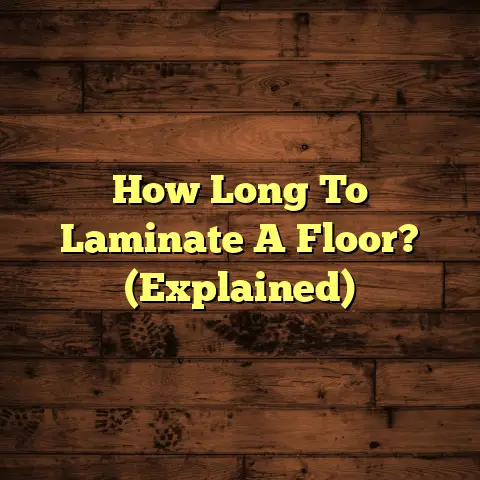Stop Beds Sliding on Wood Floors? (5 Pro Fixes!)
Wood flooring, right? I mean, who doesn’t love it?
It’s gorgeous, durable, and adds a touch of warmth that carpet just can’t match.
I’ve installed countless wood floors in my career, and I’ve seen firsthand how they can transform a home, from sleek modern condos to cozy farmhouse-style retreats.
But here’s a little secret I’ve learned over the years: even the most beautiful wood floor can become a source of frustration if your furniture starts moonwalking across it.
And let me tell you, there’s nothing quite like waking up in the middle of the night because your bed has decided to go on a little adventure!
The issue of beds sliding on wood floors is something I hear about constantly from my clients. It’s more common than you might think.
It can be annoying, a safety hazard, and over time, it can even damage your precious wood flooring. Think about it: constant friction and movement can scratch, scuff, and wear down the finish. Not ideal, right?
That’s why I decided to write this article. I’m going to share five pro-level fixes that I’ve used countless times to stop beds from sliding on wood floors. These aren’t just quick fixes; they’re solutions that will actually work, keeping your bed firmly in place and your floors protected.
Ready to say goodbye to midnight bed migrations? Let’s dive in!
Understanding the Causes of Bed Sliding
So, why does your bed suddenly decide it wants to be closer to the closet? It’s not just a matter of smooth floors. There’s actually some physics involved.
Think about it: your bed, with the mattress, pillows, and you on top, is a significant weight.
But that weight is distributed across a relatively small area – the feet of the bed frame. This creates pressure points, and on a smooth surface like wood, those pressure points can easily overcome the friction.
Friction, in simple terms, is the resistance between two surfaces. The smoother the surfaces, the less friction there is. And wood floors, especially those with a glossy finish, are pretty darn smooth.
Add to that the fact that most of us move around in our sleep (some more than others!), and you’ve got a recipe for bed-sliding disaster.
Lightweight bed frames are often the biggest culprits. I’ve seen some frames that are so light that a strong gust of wind could probably move them!
The size of the bed also plays a role. A king-size bed, for example, has a larger surface area and more potential for movement than a twin bed.
Let me share a quick story: I had a client, Sarah, who was at her wit’s end. She had a beautiful antique wood floor in her bedroom and a modern platform bed. Every morning, she’d wake up to find her bed halfway across the room!
She’d tried everything: rugs, mats, even duct tape! (Don’t laugh, I’ve seen it all!) Nothing worked.
The problem was a combination of a lightweight bed frame and the super-smooth finish on her newly refinished floors. The bed was practically ice skating across the room!
Sarah’s story isn’t unique. I’ve heard similar tales from countless homeowners. The key is to understand why your bed is sliding before you try to fix it.
Is it the weight? The frame? The floor finish? Once you know the cause, you can choose the right solution. Which brings us to our first fix…
Pro Fix #1: Adding Non-Slip Pads
Non-slip pads are probably the easiest and most affordable way to tackle a sliding bed. Think of them as little grippy superheroes for your bed frame.
There are a bunch of different types out there, but here’s a rundown of the most common ones:
-
Rubberized Pads: These are usually made of recycled rubber and provide excellent grip. They’re durable and can handle a lot of weight. I often recommend these for heavier beds.
-
Gripper Pads: These are typically made of a textured material, like felt with a rubberized coating. They’re good for lighter beds and won’t scratch your floors.
-
Adhesive Options: These pads have a sticky backing that adheres to the bed frame. They’re easy to install but might leave a residue if you ever remove them. Use with caution.
So, how do you choose the right pad? Here’s my step-by-step guide:
-
Assess Your Bed Frame: What’s it made of? If it’s metal, you might want to avoid adhesive pads, as they might not stick well. For wood frames, any type of pad will usually work.
-
Consider Your Flooring: Is your floor delicate? If so, opt for gripper pads or rubberized pads with a smooth surface. Avoid anything too abrasive.
-
Measure the Bed Legs: You’ll need to know the size of the bed legs to choose the right size pads. Most pads come in standard sizes, but it’s always good to measure.
-
Think About Weight: As I mentioned before, heavier beds need more robust pads. Rubberized pads are your best bet for heavy frames.
Installation is a breeze:
- Clean the bottom of the bed legs. Make sure they’re free of dust and debris.
- Peel off the backing (if it’s an adhesive pad).
- Stick the pads to the bottom of the bed legs, making sure they’re centered.
- That’s it! Now gently place your bed back in its desired location.
Maintenance is also super simple:
- Check the pads periodically to make sure they’re still in good condition.
- Replace them if they become worn or damaged.
- Clean the floor around the pads regularly to prevent dust and dirt from accumulating.
I’ve seen non-slip pads work wonders for clients with persistent bed-sliding issues. They’re a simple, effective, and affordable solution that anyone can implement.
Pro Fix #2: Utilizing Bed Risers
Bed risers are another fantastic option for preventing bed sliding, and they come with the added bonus of providing extra storage space under your bed!
Essentially, bed risers are small blocks that you place under the legs of your bed frame to raise it off the ground. This accomplishes a few things:
-
Increased Friction: By lifting the bed, you increase the pressure on the floor, which creates more friction and makes it harder for the bed to slide.
-
Improved Stability: Risers can help to stabilize a wobbly bed frame, which can also contribute to sliding.
-
Extra Storage: This is a huge perk for those of us living in smaller spaces. You can store bins, boxes, or even suitcases under your bed.
Bed risers come in various styles and materials:
-
Plastic Risers: These are the most affordable option and are available in a variety of heights. They’re lightweight and easy to install.
-
Wood Risers: These offer a more stylish look and are often made of solid wood. They’re sturdier than plastic risers and can support more weight.
-
Metal Risers: These are the most durable option and are ideal for heavier beds. They often feature adjustable heights.
Choosing the right bed riser involves a bit of measuring and planning:
- Measure Your Bed Legs: You need to know the diameter of your bed legs to choose risers that will fit properly.
- Determine the Desired Height: How much higher do you want your bed to be? Consider your comfort and the amount of storage space you need.
- Consider Your Bed’s Weight: Make sure the risers you choose can support the weight of your bed, mattress, and everything else on it.
Here’s how to install bed risers:
- Clear the area around your bed.
- Carefully lift one corner of your bed at a time.
- Place a riser under each leg.
- Gently lower the bed back down.
- Repeat for each corner.
It’s always a good idea to have someone help you with this process, especially if you have a heavy bed.
A word of caution: Be careful when getting in and out of bed after installing risers. The added height can take some getting used to.
I had a client, John, who used bed risers to solve his bed-sliding problem and gain some much-needed storage space in his small apartment. He was thrilled with the results.
He opted for wooden risers that matched his bed frame and instantly transformed his bedroom. Not only did his bed stop sliding, but he also had plenty of room to store his off-season clothes and shoes. Talk about a win-win!
Pro Fix #3: Leveraging Velcro Strips
Okay, this one might sound a little unconventional, but trust me, it works! Velcro strips can be a surprisingly effective solution for stopping a sliding bed.
The idea is simple: you attach one side of the Velcro strip to the bottom of the bed legs and the other side to the floor. The interlocking fibers create a strong bond that prevents the bed from moving.
Here’s why Velcro strips can be a great option:
- Strong Grip: Velcro is surprisingly strong and can hold a significant amount of weight.
- Easy to Install: Applying Velcro strips is a quick and easy process.
- Minimal Damage: When applied correctly, Velcro strips shouldn’t damage your wood floors.
- Affordable: Velcro strips are relatively inexpensive and readily available at most hardware stores.
Here’s how to properly apply Velcro strips:
- Clean the Surfaces: Make sure both the bottom of the bed legs and the area of the floor where you’ll be applying the Velcro are clean and dry.
- Cut the Strips: Cut the Velcro strips to the appropriate size for the bed legs.
- Apply the Adhesive: Peel off the backing from one side of the Velcro strip and apply it to the bottom of the bed leg. Press firmly to ensure a good bond.
- Position the Bed: Carefully position the bed in its desired location.
- Attach the Other Side: Peel off the backing from the other side of the Velcro strip and press it firmly onto the floor.
- Let it Set: Allow the adhesive to set for at least 24 hours before putting any weight on the bed.
Important Considerations:
- Use High-Quality Velcro: Opt for heavy-duty Velcro strips for the best results.
- Test in an Inconspicuous Area: Before applying Velcro to your entire floor, test it in a hidden area to make sure it doesn’t damage the finish.
- Be Careful When Removing: When removing the Velcro strips, peel them off slowly and carefully to avoid damaging the floor. You can use a heat gun or hairdryer to soften the adhesive if needed.
I had a client, Maria, who was skeptical about using Velcro strips to stop her bed from sliding. She thought it sounded too “DIY” and not professional enough. But she was desperate, so she decided to give it a try.
To her surprise, it worked like a charm! Her bed stayed put, and she was amazed at how easy the installation process was. She even sent me a “before and after” photo, showing her bed firmly in place.
Velcro strips might not be the most glamorous solution, but they’re definitely worth considering, especially if you’re on a budget or looking for a quick and easy fix.
Pro Fix #4: Choosing the Right Bed Frame
Sometimes, the problem isn’t just the floor; it’s the bed frame itself! The design and material of your bed frame can have a significant impact on its stability on wood floors.
A lightweight, poorly constructed bed frame is much more likely to slide than a heavy, well-built one.
Here are some features to look for in a bed frame that can prevent sliding:
-
Wider Legs: Bed frames with wider legs have a larger surface area in contact with the floor, which increases friction and stability.
-
Rubberized Feet: Some bed frames come with rubberized feet that provide excellent grip on wood floors.
-
Heavier Construction: A heavier bed frame is less likely to slide than a lightweight one. Look for frames made of solid wood or metal.
-
Adjustable Legs: Bed frames with adjustable legs can be leveled to ensure that all legs are in contact with the floor.
-
Center Support: A center support beam can help to distribute weight evenly and prevent the bed from wobbling.
Recommended Bed Frames:
While I can’t endorse specific brands (due to my neutral position), I can share some general types of bed frames that tend to be more stable on wood floors:
-
Platform Beds: Platform beds typically have a solid base that provides excellent stability. Look for platform beds with rubberized feet or a non-slip surface.
-
Sleigh Beds: Sleigh beds are known for their sturdy construction and often have wider legs. Just make sure the legs have some kind of protective feet.
-
Upholstered Beds: Upholstered beds often have a heavier frame and can be more stable than metal or wood frames.
What to Avoid:
- Lightweight Metal Frames: These frames are often prone to sliding, especially if they have narrow legs.
- Frames with Casters: Casters (wheels) are designed for mobility, which is the opposite of what you want if you’re trying to prevent sliding.
Investing in a high-quality bed frame is a long-term investment that can not only prevent sliding but also improve your sleep quality and overall comfort.
I had a client, David, who was constantly struggling with a cheap metal bed frame that slid all over his wood floor. He tried everything to stop it, but nothing worked.
Finally, he decided to invest in a solid wood platform bed. The difference was night and day! His new bed was incredibly stable, and he no longer had to worry about waking up in the middle of the night to find his bed halfway across the room.
Choosing the right bed frame is a crucial step in preventing bed sliding on wood floors. Don’t skimp on quality – it’s worth the investment!
Pro Fix #5: DIY Solutions
Alright, let’s get crafty! If you’re feeling adventurous and want to save some money, there are plenty of DIY solutions you can try to prevent bed sliding.
These might not be as polished as some of the other fixes I’ve mentioned, but they can be surprisingly effective, and they’re a fun way to put your creativity to the test.
Here are a few DIY ideas to get you started:
-
Custom Furniture Coasters: Cut circles of felt or rubber from an old mat and glue them to the bottom of your bed legs. This will create a non-slip surface that protects your floors and prevents sliding.
-
Foam Tape: Apply strips of double-sided foam tape to the bottom of the bed legs. This will provide a strong grip on the floor. Just be careful when removing the tape, as it can sometimes leave a residue.
-
Weighted Base: Create a weighted base for your bed frame by filling bags with sand or gravel and attaching them to the legs. This will add weight and stability to the frame.
-
Old Rug Scraps: Cut out small squares of old rugs and place them under the bed legs. The rough texture of the rug will provide traction and prevent sliding.
Important Safety Tips:
- Use Caution with Tools: When cutting or gluing materials, always use caution and follow the manufacturer’s instructions.
- Protect Your Floors: Before trying any DIY solution, test it in an inconspicuous area to make sure it doesn’t damage your floors.
- Get Help if Needed: If you’re not comfortable with DIY projects, don’t hesitate to ask a friend or family member for help.
I had a client, Lisa, who was a huge fan of DIY projects. When she told me about her bed-sliding problem, I knew she’d be up for a creative solution.
She decided to make custom furniture coasters out of felt and glue them to the bottom of her bed legs. She even decorated them with cute designs to match her bedroom decor!
Not only did her bed stop sliding, but she also had a fun and personalized touch to her bedroom. It was a win-win!
DIY solutions can be a great way to solve your bed-sliding problem while also adding a personal touch to your home. Don’t be afraid to get creative and experiment with different ideas.
Conclusion
So, there you have it: five pro-level fixes to stop your bed from sliding on wood floors. We’ve covered everything from non-slip pads to bed risers, Velcro strips, bed frame selection, and even some DIY solutions.
I know it can be frustrating to deal with a sliding bed, but I hope this article has given you some practical solutions and inspiration to tackle the problem head-on.
Remember, addressing bed sliding isn’t just about convenience; it’s also about safety. A sliding bed can be a tripping hazard, and it can also damage your precious wood floors.
Wood flooring is incredibly versatile and beautiful, and with the right fixes, you can enjoy its beauty without the hassle of moving furniture.
Take some time to assess your specific situation and consider which of these fixes might work best for you. Do you have a lightweight bed frame? Are your floors particularly slippery? Are you looking for a quick and easy solution or a more long-term fix?
Once you’ve answered these questions, you can choose the right approach and take action to enhance your living space.
Don’t let a sliding bed ruin your sleep or damage your floors. Implement these pro fixes and enjoy a stable, comfortable, and safe bedroom environment.
And if you’re ever in doubt, don’t hesitate to consult with a professional flooring contractor (like yours truly!). We’re always happy to help!





